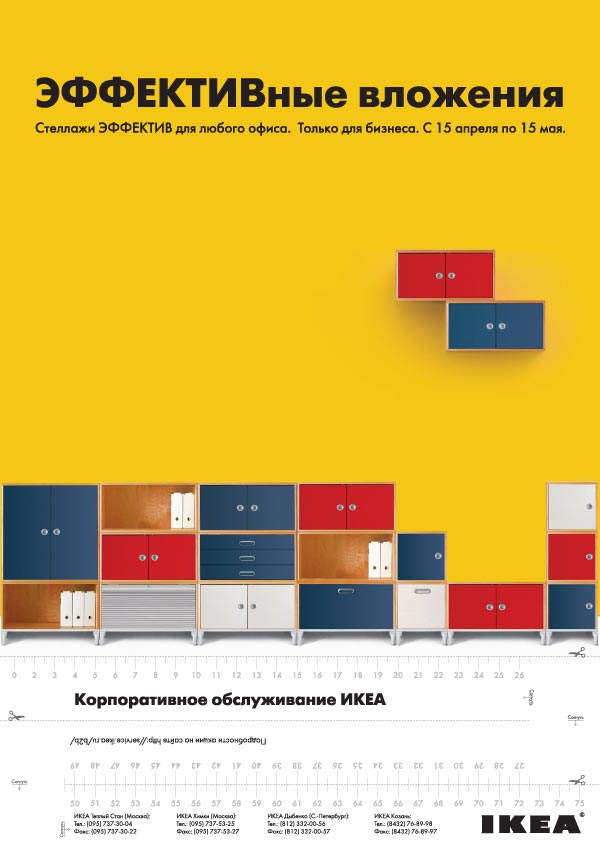Graphic Design: Difference between revisions
Jump to navigation
Jump to search
No edit summary |
m Reverted edit of 216.60.21.5, changed back to last version by Iwolf |
||
| (6 intermediate revisions by 3 users not shown) | |||
| Line 1: | Line 1: | ||
{{Definition|'''Graphic design''' is the applied art of arranging image and text to communicate a message. | {{Definition|'''Graphic design''' is the applied art of arranging image and text to communicate a message. It may be applied in any media such as print, digital media, motion picture, animation, product decoration, packaging, signs, identities, etc. Graphic design as a practice can be traced back to the origin of the written word, but only in the late 19th century did it become identified as a separate entity. [Wikipedia, 2005]}} | ||
<center>''Read full article on [[wikipedia:Graphic design|Wikipedia]]''</center> | |||
[[Image:graphicdesign.jpg|thumb|250px|Graphic design: ''IKEA''–commercial by Art Lebedev]] | [[Image:graphicdesign.jpg|thumb|250px|Graphic design: ''IKEA''–commercial by Art Lebedev]] | ||
Trying to communicate complex information by forming a visually intuitive representation graphic design turns out to be a special case of [[information visualization]], yet it tends to ignore the practical doctrine of ''form follows function'' — the sole guideline for | {{Quotation|The practice or profession of designing print or electronic forms of visual information, as for an advertisement, publication, or website.|[Houghton Mifflin, 2000]}} | ||
{{Quotation|the art or profession of visual communication that combines images, words, and ideas to convey information to an audience, esp. to produce a specific effect.|[Infoplease, 2004]}} | |||
Trying to communicate complex information by forming a visually intuitive representation graphic design turns out to be a special case of [[information visualization]], yet it tends to ignore the practical doctrine of ''form follows function'' — the sole guideline for [[Information visualization|InfoVis]] — and tries to produce not only useful, but even more aethetically satisfying (''stylish'') visual impressions. | |||
== External links == | == External links == | ||
| Line 10: | Line 17: | ||
*[http://www.klassehickmann.com/ Klasse Hickmann]: Graphic design project at the ''University of Applied Arts Vienna'' | *[http://www.klassehickmann.com/ Klasse Hickmann]: Graphic design project at the ''University of Applied Arts Vienna'' | ||
*[http://www.designerinaction.de ''Designer in Action''] | *[http://www.designerinaction.de ''Designer in Action''] | ||
== References == | |||
*[Wikipedia, 2005] wikipedia.org. Graphic design. Retrieved at: September 12, 2005. http://en.wikipedia.org/wiki/Graphic_Design | |||
*[Houghton Mifflin, 2000] Houghton Mifflin Company, The American Heritage® Dictionary of the English Language, Fourth Edition, Houghton Mifflin Company, 2000. | |||
*[Infoplease, 2004] Infoplease. Definition of ''graphic design''. Retrieved at: November 18, 2004. Pearson Education, publishing as Infoplease. http://www.infoplease.com/dictionary/graphic design | |||
[[Category: Glossary]] | [[Category: Glossary]] | ||
Latest revision as of 08:52, 19 April 2006
Graphic design is the applied art of arranging image and text to communicate a message. It may be applied in any media such as print, digital media, motion picture, animation, product decoration, packaging, signs, identities, etc. Graphic design as a practice can be traced back to the origin of the written word, but only in the late 19th century did it become identified as a separate entity. [Wikipedia, 2005]

The practice or profession of designing print or electronic forms of visual information, as for an advertisement, publication, or website.
[Houghton Mifflin, 2000]
the art or profession of visual communication that combines images, words, and ideas to convey information to an audience, esp. to produce a specific effect.
[Infoplease, 2004]
Trying to communicate complex information by forming a visually intuitive representation graphic design turns out to be a special case of information visualization, yet it tends to ignore the practical doctrine of form follows function — the sole guideline for InfoVis — and tries to produce not only useful, but even more aethetically satisfying (stylish) visual impressions.
External links
- ArtLebedev–Studio
- Klasse Hickmann: Graphic design project at the University of Applied Arts Vienna
- Designer in Action
References
- [Wikipedia, 2005] wikipedia.org. Graphic design. Retrieved at: September 12, 2005. http://en.wikipedia.org/wiki/Graphic_Design
- [Houghton Mifflin, 2000] Houghton Mifflin Company, The American Heritage® Dictionary of the English Language, Fourth Edition, Houghton Mifflin Company, 2000.
- [Infoplease, 2004] Infoplease. Definition of graphic design. Retrieved at: November 18, 2004. Pearson Education, publishing as Infoplease. http://www.infoplease.com/dictionary/graphic design